- Table of Content
- 1.Solar Orbiter ...
- 2.SWIC and sweat
- 3.Review of sola...
- 4.The Internatio...
- 5.PROBA2 Observa...
- 6.Review of geom...
- 7.Geomagnetic Ob...
- 8.The SIDC Space...
- 9.Review of iono...
- 10.Action!
2. SWIC and sweat
3. Review of solar activity
4. The International Sunspot Number by Silso
5. PROBA2 Observations
6. Review of geomagnetic activity
7. Geomagnetic Observations in Belgium
8. The SIDC Space Weather Briefing
9. Review of ionospheric activity
10. Action!
Solar Orbiter returns to Earth for a last goodbye
On 27 November 2021, the Solar Orbiter spacecraft returns from its voyages in deep space, and will pass at only a few hundred kilometers above the Earth's surface. This manoeuvre is needed to get Solar Orbiter in a new orbit to go yet closer to the Sun. During this flyby, Solar Orbiter unfortunately needs to cross the clouds of space junk that surround Earth, making it a risky visit to our planet.
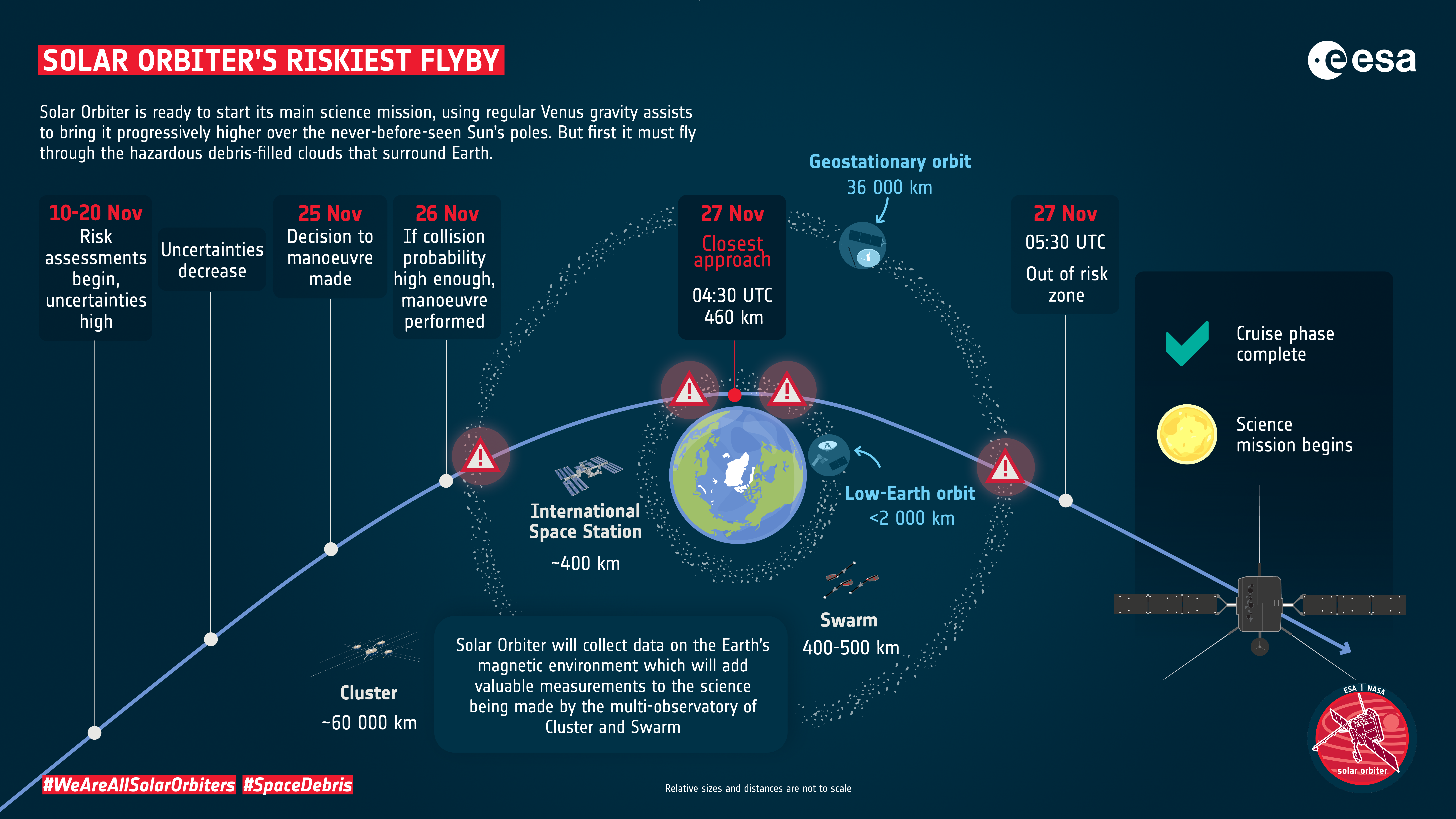
Solar Orbiter’s Earth flyby takes place on 27 November. At 04:30 UTC (05:30 CET) on that day, the spacecraft will be at its closest approach, just 460 km above North Africa and the Canary Islands.
Space Debris
At closest approach, the spacecraft will be at 460 km above North Africa. This height is called the Low Earth Orbit zone, where the International Space Station and many other spacecraft can be found. It is also home to a lot of space trash, increasing the risk of a collision. Before Solar Orbiter reaches this region, it will also fly through another frequently-used zone, the Geostationary orbit, which again is congested with space trash and other satellites. ESA will monitor the situation carefully and change the trajectory of the Solar Orbiter spacecraft if it appears to be in any danger.
Heading towards more science
The flyby marks a major milestone for Solar Orbiter. After this last goodbye to Earth, the spacecraft will be put in orbit to start its scientific mission. Following the launch in February 2020, the spacecraft and all instruments onboard have been thoroughly tested. Despite Solar Orbiter not yet being in full science mode, the instruments were already taking data as often as possible and a lot of science has been produced, far exceeding the expectations. An upgrade to the ESA Ground Station Network allowed Solar Orbiter to send more data down to Earth, and the mission’s scientists have fully taken advantage of this.
Closest approach
In March 2022, Solar Orbiter will make its closest approach to the Sun yet, a phase in the orbit called perihelion. Its first perihelion took place in June 2020, with the spacecraft going nearly twice as close to the Sun as the Earth is. This time, Solar Orbiter will go yet closer and arrive well within the orbit of Mercury – providing a significant boost to the science that can be done. No solar telescope has ever imaged the solar atmosphere from that closeby! “All the interesting high resolution images that we've already got till now, will be zoomed in by almost a factor of two,” says Daniel Müller, Solar Orbiter Project Scientist.
Campfires
This includes new views of the enigmatic ‘campfires’ that Solar Orbiter saw at the first perihelion. The campfires could hold clues about how the Sun’s outer atmosphere has a temperature of millions of degrees, while the surface has a temperature of thousands – which seemingly defies physics because heat should not be able to flow from a colder to a hotter object. Cis Verbeeck, Consortium Project Manager of the EUI instrument onboard that images the Sun at very high resolution, excitedly explains that these early observations have shown that campfires are everywhere in the solar atmosphere and appear to be small versions of solar flares at much lower heights than regular flares.
After the flyby, when Solar Orbiter re-emerges from the Earth’s shadow, it will be on its course for a close rendezvous with the Sun. Unique observations have already been scheduled, and exciting times for our understanding of our mother star are expected!
SWIC and sweat
At the time of writing, the 8 participants of our Space Weather Introductory Course are working and sweating on their exam.
Good luck René, Eric, Frans, Mourad, Haldis, Olivier, Justyna and Arnaud!

Piece of art to illustrate space weather impact on the ionosphere.
Review of solar activity
Alpha regions NOAA 2894, 2896 and 2897 were present on the side of the Sun facing Earth. The GOES X-ray flux background varied between A2 and B1 level. No C, M or X flares were measures by GOES.
No Earth-directed Coronal Mass Ejections were observed in coronagraphic imagery.
The greater than 10 MeV proton flux was nominal.
The greater than 2 MeV electron flux briefly reached moderate levels on November 14 and 15 and was nominal throughout the rest of the week. The greater than 2 MeV electron fluence (24h) was nominal throughout the week.
The International Sunspot Number by Silso
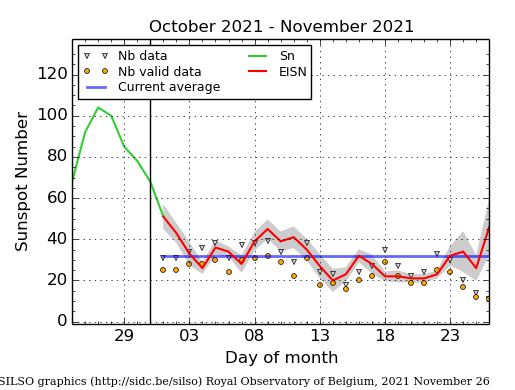
The daily Estimated International Sunspot Number (EISN, red curve with shaded error) derived by a simplified method from real-time data from the worldwide SILSO network. It extends the official Sunspot Number from the full processing of the preceding month (green line), a few days more than one solar rotation. The horizontal blue line shows the current monthly average. The yellow dots gives the number of stations that provided valid data. Valid data are used to calculate the EISN. The triangle gives the number of stations providing data. When a triangle and a yellow dot coincide, it means that all the data is used to calculate the EISN of that day.
PROBA2 Observations
Solar Activity
Solar flare activity was very low during the week.
In order to view the activity of this week in more detail, we suggest to go to the following website from which all the daily (normal and difference) movies can be accessed: https://proba2.oma.be/ssa
This page also lists the recorded flaring events.
A weekly overview movie can be found here (SWAP week 608): https://proba2.sidc.be/swap/data/mpg/movies/weekly_movies/weekly_movie_2021_11_15.mp4
Details about some of this week's events can be found further below.
If any of the linked movies are unavailable they can be found in the P2SC movie repository here: https://proba2.oma.be/swap/data/mpg/movies/
Saturday Nov 20
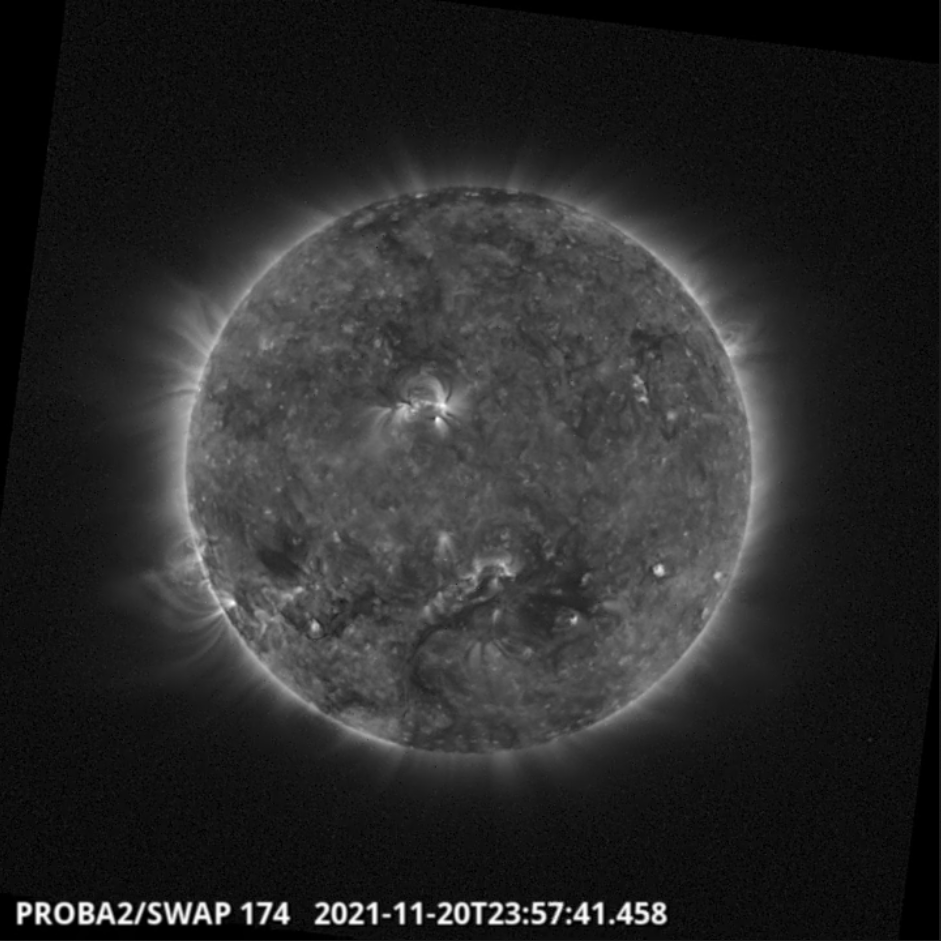
A large filament was visible on the disk for much of the week. The filament can be seen in the southern hemisphere near the central meridian on 2021-Nov-20, as shown in the SWAP image above taken at 23:57 UT.
Find a movie of the event here (SWAP movie): https://proba2.sidc.be/swap/movies/20211120_swap_movie.mp4
Review of geomagnetic activity
A high speed stream from a negative polarity extension of the south polar coronal hole arrived near Earth around 15:00 UT on November 15. The solar wind speed as registered by DSCOVR reached a maximum of about 630 km/s and the magnitude of the Interplanetary Magnetic Field near Earth (IMF) attained a maximum of about 23 nT.
A high speed stream from another negative polarity extension of the south polar coronal hole arrived near Earth around 03:55 UT on November 20, leading to a maximum solar wind speed of about 695 km/s and a maximum IMF magnitude of about 10 nT.
Because the IMF values were only elevated during two brief periods without extended negative Bz excursions, K-BEL stayed below 4, i.e. quiet conditions and NOAA Kp reached 4, i.e. active conditions.
Geomagnetic Observations in Belgium
Local K-type magnetic activity index for Belgium based on data from Dourbes (DOU) and Manhay (MAB). Comparing the data from both measurement stations allows to reliably remove outliers from the magnetic data. At the same time the operational service availability is improved: whenever data from one observatory is not available, the single-station index obtained from the other can be used as a fallback system.
Both the two-station index and the single station indices are available on http://ionosphere.meteo.be/geomagnetism/K_BEL/
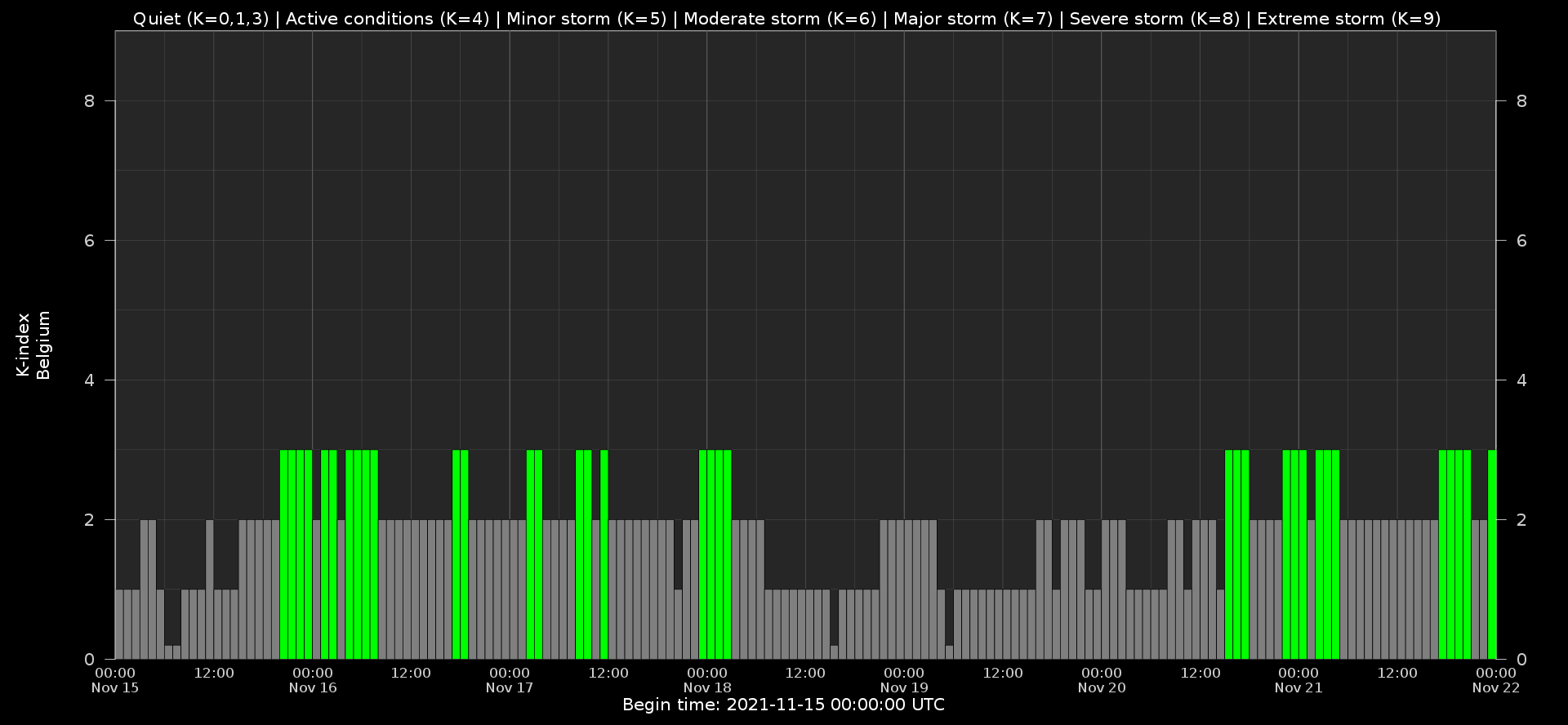
The SIDC Space Weather Briefing
The Space Weather Briefing presented by the forecaster on duty from Nov 14 to 21. It reflects in images and graphs what is written in the Solar and Geomagnetic Activity report.

A pdf-version: https://www.stce.be/briefings/20211122_SWbriefing.pdf
The movie: https://www.stce.be/briefings/20211122_SWbriefing.m4v
Review of ionospheric activity
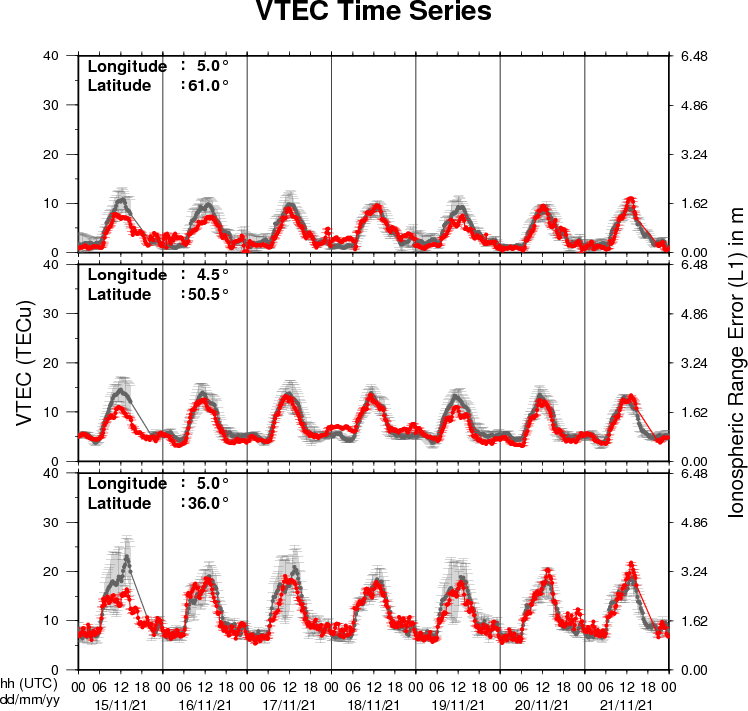
The figure shows the time evolution of the Vertical Total Electron Content (VTEC) (in red) during the last week at three locations:
a) in the northern part of Europe(N61�, 5�E)
b) above Brussels(N50.5�, 4.5�E)
c) in the southern part of Europe(N36�, 5�E)
This figure also shows (in grey) the normal ionospheric behaviour expected based on the median VTEC from the 15 previous days.
The VTEC is expressed in TECu (with TECu=10^16 electrons per square meter) and is directly related to the signal propagation delay due to the ionosphere (in figure: delay on GPS L1 frequency).
The Sun's radiation ionizes the Earth's upper atmosphere, the ionosphere, located from about 60km to 1000km above the Earth's surface.The ionization process in the ionosphere produces ions and free electrons. These electrons perturb the propagation of the GNSS (Global Navigation Satellite System) signals by inducing a so-called ionospheric delay.
See http://stce.be/newsletter/GNSS_final.pdf for some more explanations ; for detailed information, see http://gnss.be/ionosphere_tutorial.php
Action!
Check out our activity calendar: activities and encounters with the Sun-Space-Earth system and Space Weather as main theme. We provide occasions to get submerged in our world through educational, informative and instructive activities.
If you want your event in our calendar, contact us: stce_coordination at stce.be
in 2021
* November 22 - 26, Online SWx introductory Course (SWIC), organisation by the STCE - ongoing
* November 28, Dag van de wetenschap, Brussels, Belgium - STCE will bring 'Panic in the Space Weather Room' (Dutch) - CANCELLED due to COVID
* December 2, ISSI Game Changers Online Seminars: Tipping positive change to avoid climate tipping points
* December 3-4, Space Days at the Big Bang festival, STCE will bring 'Panic in the Space Weather Room' and 'Satellites' - CANCELLED due to COVID
* December 9, ISSI Game Changers Online Seminars: Space Weather
* December 16, ISSI Game Changers Online Seminars: Sursurface Life on Earth and on Other Planets in the Solar System
In 2022
* January 25, Public Lecture on the Solar Corona in EUV (Dutch), Urania, Hove, Belgium
* February 14-18, online Space Weather Introductory Course by SWEC, Space Weather Education Center - registrations are open
* February 22, Public Lecture on Space Weather and Aviation (Dutch), Urania, Hove, Belgium
* February 26, Public Lecture on Space Weather, Satellites and Aviation (Dutch), UGent Volkssterrenwacht Armand Pien, Gent, Belgium
* March 14-16, onsite (!) Space Weather Introductory Course by SWEC, Space Weather Education Center - registrations are open
* April 28, Public Lecture on SDO/EUI, Astropolis, Oostende, Belgium
* August 25, Public Lecture on Space Weather and Aviation, Astropolis, Oostende, Belgium
* October 24-28, 18th European Space Weather Week, Zagreb, Croatia
Check: https://www.stce.be/calendar
